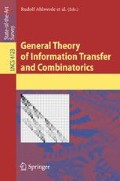Abstract
In this work the concept of identification is applied in the theory of prediction. This approach was suggested to us by our advisor Professor R. Ahlswede. This and other directions of research can be found also in [2]. Well known is Shannon’s theory of transmission of messages over a noisy channel ([15]). Using the framework of Shannon’s channel model a new concept of information transfer – called identification – was introduced by Ahlswede and Dueck in [1].
Access this chapter
Tax calculation will be finalised at checkout
Purchases are for personal use only
Preview
Unable to display preview. Download preview PDF.
References
Ahlswede, R., Dueck, G.: Identification via channels. IEEE Trans. Inform. Theory 35(1), 15–29 (1989)
Ahlswede, R.: General theory of information transfer, Preprint 97–118, SFB 343 Diskrete Strukturen in der Mathematik, Universität Bielefeld (1997); General theory of information transfer:updated, General Theory of Information Transfer and Combinatorics, a Special Issue of Discrete Applied Mathematics (to appear)
Algoet, P.H.: The strong law of large numbers for sequential decisions under uncertainty. IEEE Trans. Inform. Theory 40(3), 609–633 (1994)
Blackwell, D.: An analog to the minimax theorem for vector payoffs. Pac. J. Math. 6, 1–8 (1956)
Blackwell, D.: Controlled random walks. In: Proc. Int. Congr. Mathematicians, 1954, vol. III, pp. 336–338. North Holland, Amsterdam (1956)
Cover, T.M., Shenhar, A.: Compound Bayes predictors for sequences with apparent Markov structure. IEEE Trans. Syst. Man Cybern. SMC-7, 421–424 (1977)
Cover, T.M.: Behavior of sequential predictors of binary sequences. In: Proc. 4th Prague Conf. Inform. Theory, Statistical Decision Functions, Random Processes, 1965, pp. 263–272. Publishing House of the Czechoslovak Academy of Sciences, Prague (1967)
Feder, M., Merhav, N., Gutman, M.: Universal prediction of individual sequences. IEEE Trans. Inform. Theory 38(4), 1258–1270 (1992)
Feder, M., Merhav, N., Gutman, M.: Some properties of sequential predictors for binary Markov sources. IEEE Trans. Inform. Theory 39(3), 887–892 (1993)
Feder, M., Merhav, N.: Universal schemes for sequential decision from individual data sequences. IEEE Trans. Inform. Theory 39(4), 1280–1292 (1993)
Feder, M., Merhav, N.: Relations between entropy and error probability. IEEE Trans. Inform. Theory 40(1), 259–266 (1994)
Hannan, J.F., Robbins, H.: Asymptotic solutions of the compound decision problem for two completely specified distributions. Ann. Math. Statist. 26, 37–51 (1957)
Hannan, J.F.: Approximation to Bayes risk in repeated plays, Contributions to the Theory of Games. Annals of Mathematics Studies, vol. III, Princeton, NJ, No. 39, pp. 97–139 (1957)
Robbins, H.: Asymptotically subminimax solutions of compound statistical decision problems. In: Proc. 2nd Berkeley Symp. Math. Stat. Probab., pp. 131–148 (1951)
Shannon, C.E.: A mathematical theory of communication. Bell System Tech. J. 27, 379–423, 623–656 (1948)
Shannon, C.E.: Prediction and entropy of printed English. Bell Sys. Tech. J. 30, 5–64 (1951)
Shannon, C.E.: The mind reading machine. In: Wyner, A.D., Sloane, N.J.A. (eds.) Bell Laboratories Memorandum, 1953: Shannon’s Collected Papers, pp. 688–689. IEEE Press, Los Alamitos (1993)
Author information
Authors and Affiliations
Editor information
Editors and Affiliations
Rights and permissions
Copyright information
© 2006 Springer-Verlag Berlin Heidelberg
About this chapter
Cite this chapter
Bäumer, L. (2006). Identification and Prediction. In: Ahlswede, R., et al. General Theory of Information Transfer and Combinatorics. Lecture Notes in Computer Science, vol 4123. Springer, Berlin, Heidelberg. https://doi.org/10.1007/11889342_6
Download citation
DOI: https://doi.org/10.1007/11889342_6
Publisher Name: Springer, Berlin, Heidelberg
Print ISBN: 978-3-540-46244-6
Online ISBN: 978-3-540-46245-3
eBook Packages: Computer ScienceComputer Science (R0)

